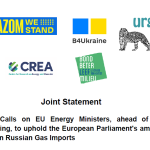Target levels need to be consistent with the 1.5°C Paris Agreement goal: In order to address the climate emergency and limit temperature increase in line with the objectives of the Paris Agreement, imminent and deep emission cuts before 2030 are decisive. If action is insufficient now, it will likely be impossible to make up for the deficit later. The IPCC has shown that missing the 1.5°C temperature target will cause severe additional and irreversible damages to the global ecosystem and spiralling global heating out of human control.
Against this backdrop and in line with the EU precautionary principle, the definition of the EU climate targets should be based on assessments aiming to meet the 1.5°C goal with the highest chance possible, certainly higher than 50%. In light of the EUs global and historic responsibility and its capacity to act, the impact assessment must also consider emission reduction pathways enabling the EU to achieve at least -65% gross emissions reductions by 2030 and net zero emissions by 2040 at the latest, based on a 100% renewable energy system. At the same time, it should integrate the adoption of a climate target for 2035, as well as establish 5 year policy cycles in line with the common time frames at UNFCCC level.
Furthermore, the European climate and energy framework is based on three mutually reinforcing targets, the EU GHG emission reduction target, the EU renewable energies target and the EU energy efficiency target, and that an increase in climate ambition needs to go hand in hand with more ambitious energy targets. Ensure technological assumption reflect realities: The technological assumptions used to develop the different pathways and policy options, need to reflect the latest available data on estimated costs and efficiency, as also emphasised by the ESABCC advice in January 2023. Relying on outdated data risks creating a bias in the modelling results, and therefore in the resulting ambition levels, by overestimating the costs and underestimating the benefits of green technologies.
Deployment costs for renewable energies have consistently decreased in recent years and key technologies for the transition such as heat pumps and electric boilers are becoming increasingly cost-competitive. Comparisons with more regularly updated sources underline the need to improve the cost reference for electric boilers, the efficiency assumptions for heat pumps and revise the overestimated efficiency assumptions for residential gas boilers in the Commission reference scenario. Factor in cost of inaction, impacts on future generations and co-benefits as well as hidden costs of alternatives: Insufficient responses to the climate crisis today will cause far reaching and irreversible damages to future generations.
These damages, largely borne by the most vulnerable groups already today, range from direct impacts associated with more frequent and intensive extreme weather events to associated conflicts over water, resources and materials, strains on public health and welfare systems and increasing wealth inequality globally and regionally. Any assessment of increased climate action needs to draw the full picture of its direct benefits (e.g. employment, public health, reduced energy costs and import dependency, competitiveness) and avoided costs (e.g. environmental damage, healthcare costs, fossil fuel subsidies).
Specifically, the impact assessment should take an intersectional approach (focusing on gender, race, disabilities, age) and needs to assess the impact action and inaction will have on human rights and restrictions of fundamental freedoms of current and future generations. For all available technologies, the full costs have to be assessed; for example regarding land use of energy, e.g. bioenergy, opportunity costs of alternative use of the land for sinks, loss of biodiversity, and an increase of costs for competing material uses that are ranked higher in the cascading hierarchy need to be factored in.
Submission to the public consultation on the EU climate target for 2040 & an equitable EU GHG budget
Questionnaire: Public consultation on the EU climate target for 2040



